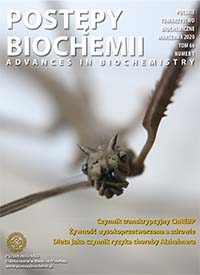Contribution of BRG1-dependent SWI/SNF complexes to determining the phenotype of cancer cell
Role of BRG1 in cancers
DOI:
https://doi.org/10.18388/pb.2020_312Abstract
ATP-dependent chromatin remodeling complexes are documented as indispensible element of epigenetic mechanisms, which control transcription. These multiprotein functional units are capable of insertion, deletion and sliding of nucleosomes at the gene regulatory elements thereby defining DNA accessibility to transcription machinery. SWI/SNF is one out of four identified and described complexes. The enzymatic role in SWI/SNF molecular âmotors” is assigned to two ATP-ases: BRM and BRG1. Accumulating evidence suggests the link between BRG1 and pathophysiology of some types of cancer. BRG1 has been documented as an activator of genes encoding factors responsible for i.a. proliferation, DNA repair, transmembrane transport and metabolism. Therefore, inhibitors of BRG1 and co-operating enzymes, which modulate activity of this ATP-ase or mark histones for shuttling to/from the chromatin, may turn out as an alternative to the compounds that are currently used to suppress the growth of tumors or as supplements that increase cell vulnerability to anticancer drugs.
Downloads
Published
Issue
Section
License
Copyright (c) 2020 Advances in Biochemistry

This work is licensed under a Creative Commons Attribution 4.0 International License.
All journal contents are distributed under the Creative Commons Attribution-ShareAlike 4.0 International (CC BY-SA 4.0) license. Everybody may use the content following terms: Attribution — You must give appropriate credit, provide a link to the license, and indicate if changes were made, ShareAlike — If you remix, transform, or build upon the material, you must distribute your contributions under the same license as the original. There are no additional restrictions — You may not apply legal terms or technological measures that legally restrict others from doing anything the license permits.
Copyright for all published papers © stays with the authors.
Copyright for the journal: © Polish Biochemical Society.




